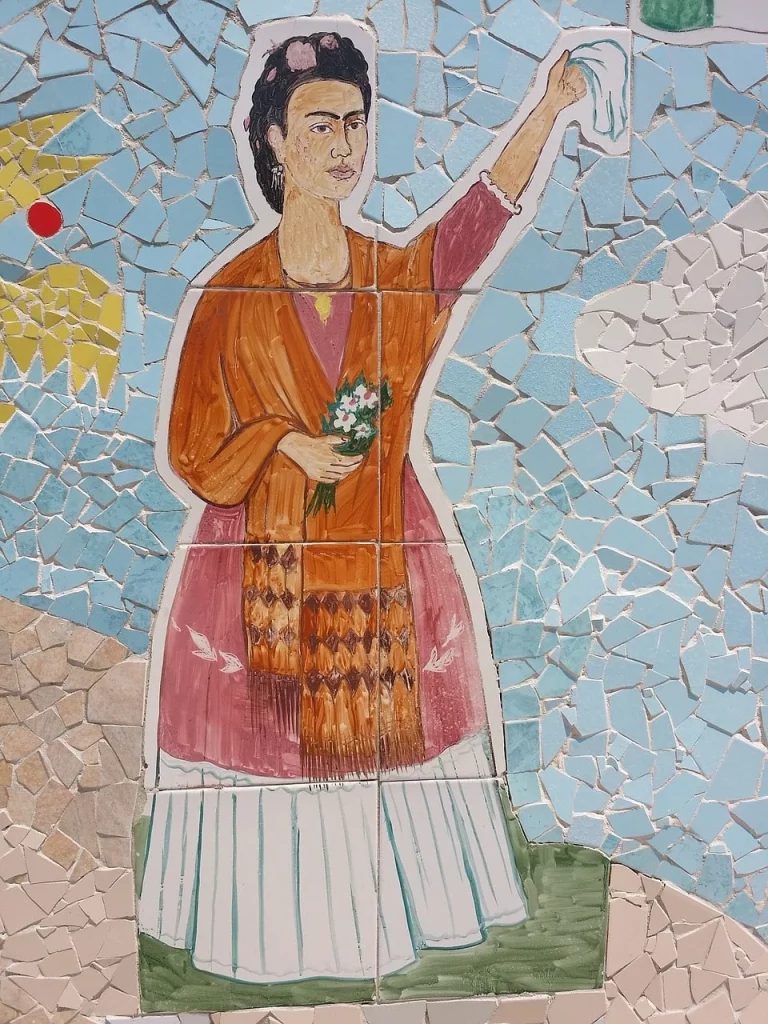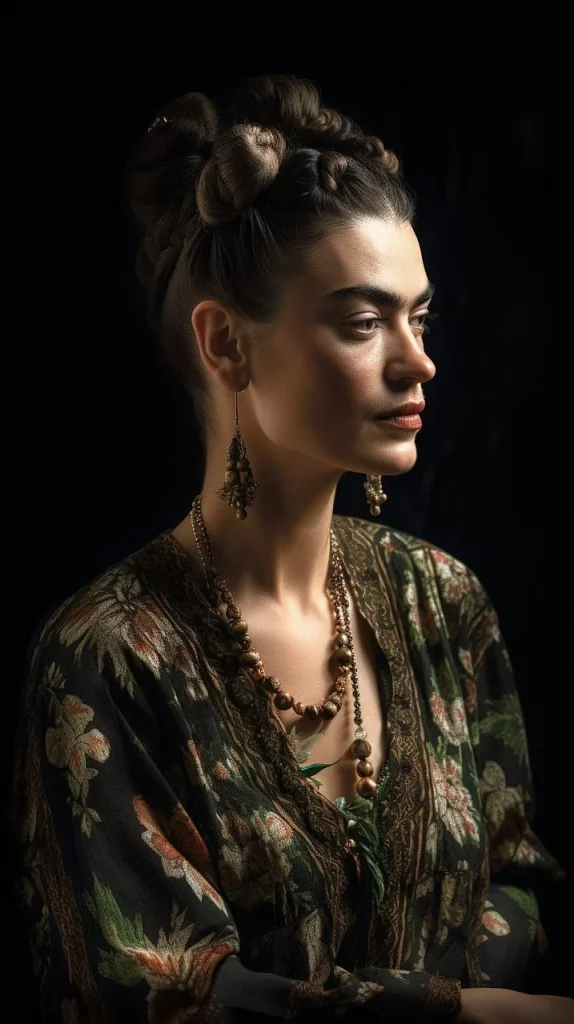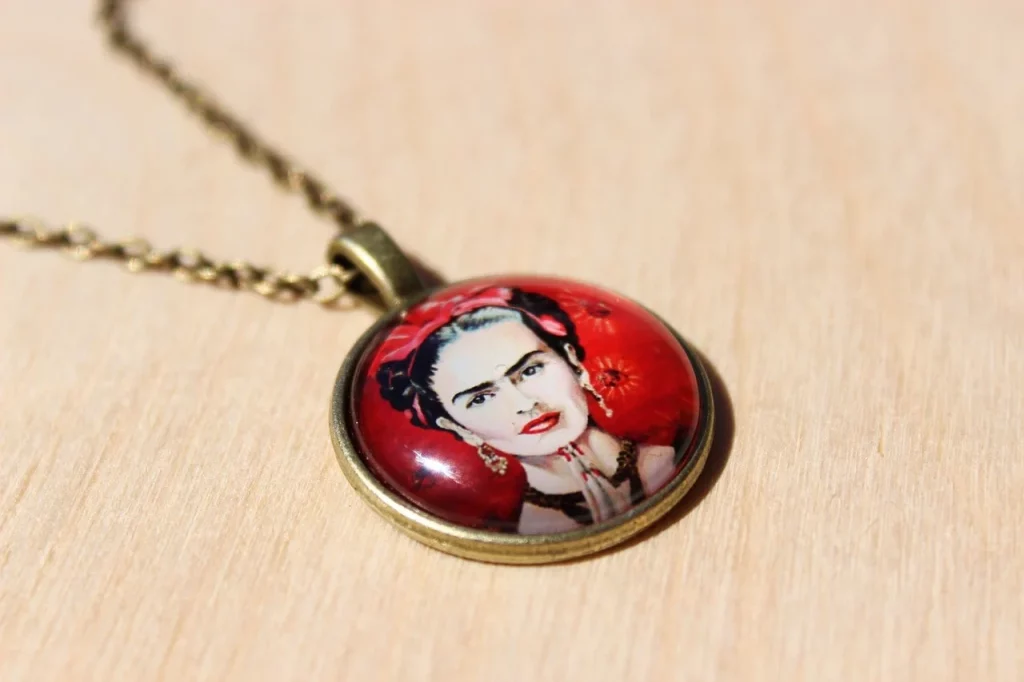Frida Kahlo’s life was as rich and colorful as her art. Born in the early 20th century in Mexico, Kahlo became much more than a gifted painter; she was a cultural icon, a feminist symbol, and a pioneer in expressing the complexities of identity and the human body.
Her self-portraits, characterized by their vivid colors and intense emotion, offer a window into her soul, revealing a story marked by tragedy, love, and unyielding courage.
In this journey through some remarkable facts about Frida Kahlo, we will uncover the layers of this extraordinary artist, whose legacy transcends time and continues to inspire millions around the world.
Frida Kahlo is, without a doubt, the most original and powerful artist, not only in Mexico but in all of America.
Carlos Fuentes
Frida Kahlo Facts
Get ready to explore the intriguing life of Frida Kahlo. Remember, your attention to detail will be tested at the end of this article through a quiz. Show off your knowledge and claim your title as a Kahlo connoisseur!
- Frida Kahlo’s birth occurred on July 6, 1907, within the confines of Coyoacán, Mexico City, Mexico.
- Although 1907 marks her actual birth year, she frequently claimed 1910, aligning her birth with the start of the Mexican Revolution, to symbolize her connection with the emergence of modern Mexico.
- Her full name at birth was Magdalena Carmen Frida Kahlo y Calderón.
- At age 6, Kahlo suffered from polio, leading to a noticeable thinness in her right leg compared to the left, a condition she concealed with long skirts.
- Originally aspiring to a medical career, her dreams were derailed by a devastating bus accident at 18, which led her to discover her passion for painting during her convalescence.
- This accident inflicted persistent pain and health complications throughout her life, profoundly influencing her artistic expressions.
- Kahlo is renowned for her use of intense colors and symbolic elements, often reflecting her intimate experiences, and her physical and psychological suffering.
- She was married to the celebrated Mexican muralist Diego Rivera in 1929.
- Their marriage was marked by tumult, including multiple infidelities by both parties; they divorced in 1939 but remarried the following year.
- Kahlo played a significant role in the Mexican Communist Party, and her political ideologies frequently influenced her artistic work.
- A significant portion of her artistic oeuvre consists of self-portraits, offering a window into her personal experiences and her enduring physical agony.
- Her acclaimed painting, “The Two Fridas” (1939), depicts dual self-representations with exposed hearts, symbolizing her complex inner life.
- 1938 marked the year of her first individual exhibition in New York City, which achieved considerable acclaim.

- She maintained friendships with several prominent personalities of her era, including Pablo Picasso and Marcel Duchamp.
- Despite enduring pain, Kahlo’s reputation was one of a lively spirit and resilience.
- One of her final works, “Viva la Vida, Watermelons” (1954), reflects her unyielding passion for life amidst her health struggles.
- Kahlo’s death came on July 13, 1954, at 47 years old. Officially attributed to pulmonary embolism, some speculate it may have been a case of suicide.
- Her residence, known as “La Casa Azul” (The Blue House), located in Coyoacán, Mexico City, now serves as a museum commemorating her life and art.
- Her distinct style, characterized by rich colors and a blend of realism with symbolism, has cemented her status as an icon of Mexican heritage and feminism.
- Posthumously, her art has been celebrated in numerous global exhibitions, and her life has inspired a myriad of books, films, and theatrical productions.
- Approximately 200 paintings are attributed to Kahlo, as her ability to paint was often hindered by her health.
- She frequently incorporated animal symbolism in her art, such as monkeys and parrots, representing fertility and companionship.
- Kahlo’s father, Guillermo Kahlo, was a German-born photographer who significantly influenced her artistic inclinations.
- Throughout her life, she underwent around 35 surgical procedures due to the aftermath of her bus accident and deteriorating health.
- Her art gained broader recognition after her demise, especially from the late 1970s to the 1980s, rediscovered by art historians and political activists.
- The Frida Kahlo Museum, or La Casa Azul, annually attracts hundreds of thousands of visitors.
- Kahlo’s unique appearance, marked by her iconic unibrow and traditional Tehuana attire, became a symbol of her identity and cultural roots.
- She led a vibrant social life, hosting numerous renowned artists and political figures at her residence.

- Her art was exhibited in Paris in 1939, making her the first Mexican artist to have a solo exhibition at the Louvre.
- Her painting, “Roots” (1943), set a sales record for a Latin American artwork at auction, fetching $5.6 million in 2006.
- Her art delves into themes of identity and femininity, often exploring these concepts deeply.
- Kahlo’s influence pervades contemporary fashion, music, and pop culture, inspiring a wide array of artists.
- Her artworks are showcased in prestigious institutions worldwide, including New York’s Museum of Modern Art and the Museo Frida Kahlo in Mexico City.
- She held a lifelong fascination with indigenous Mexican culture, which influenced both her artistic style and personal fashion.
- Kahlo’s marriage to Rivera was a profound source of both inspiration and anguish, as reflected in her artworks.
- She was unable to have children, partly due to the severe injuries from her bus accident and subsequent health complications.
- Kahlo’s artistic prowess was predominantly self-taught, drawing from her cultural background, personal experiences, and pain.
- She was acquainted with Leon Trotsky, the Russian revolutionary leader, during his Mexican sojourn.

- While famed for her self-portraits, Kahlo also created still lifes and occasional landscape paintings.
- Her global recognition grew significantly in the late 20th century, establishing her as an international cultural icon.
- Her work, “Henry Ford Hospital” (1932), depicting her miscarriage, is among her most emotionally powerful pieces.
- Kahlo used her art to explore themes like identity, postcolonialism, gender, class, and race within Mexican society.
- Her legacy has surpassed that of Diego Rivera in recent times, symbolizing strength and creative expression.
- The establishment of the Frida Kahlo Corporation manages the licensing and commercial aspects of her name and imagery.
- Kahlo became a beacon for the feminist movement in the 1970s, resonating with themes of womanhood and self-empowerment.
- Her art, notable for its bold, vivid colors and intricate detailing, has had a significant impact on contemporary art.
- Despite her widespread fame, Kahlo’s art remained intensely personal and autobiographical, offering a unique perspective into her life.
- She is often hailed as a pivotal 20th-century artist and a key figure in the movement of Mexican modernism.
- Kahlo’s image and artworks have become emblematic in various social movements, particularly those advocating for women’s rights and the LGBTQ+ community.
- Kahlo’s artistic legacy continues to inspire and influence a diverse range of fields, from art therapy to feminist studies, demonstrating the enduring impact of her life and work on contemporary culture and thought.
Frida Kahlo Myths

Having explored all these remarkable facts about Frida Kahlo’s life and art, let’s now venture into a different realm. We will delve into the myths surrounding her, discerning the line between truth and fiction.
- Frida Kahlo’s Art Was Mainly Surrealist
While often associated with surrealism, Kahlo’s work was deeply personal and rooted in her own experiences and Mexican culture. Her paintings, rich in symbolism and vivid imagery, reflect her physical and emotional pain, her relationship with Diego Rivera, and her political beliefs. Surrealists themselves admired her work, but Kahlo stated, “I never painted dreams. I painted my own reality.“ - She Became Famous as an Artist During Her Lifetime
She was relatively unknown as an artist during most of her life. It was not until the late 1970s and 1980s, long after her death, that her work gained significant recognition. This surge in popularity was partly due to the feminist movement, which embraced her as an icon of female creativity and resilience. - Her Career Was Overshadowed by Diego Rivera
While it’s true that Diego Rivera, her husband, was more famous during their lifetimes, Kahlo’s artistic identity and success were distinct and independent. Her work was celebrated for its unique style and deep personal expression, contrasting with Rivera’s large-scale murals. Today, Kahlo is often considered the more influential artist of the two. - Kahlo’s Main Subject Was Female Pain and Suffering
Although pain and suffering are prominent themes in her work, her art encompasses a broader range of subjects. She explored topics like identity, politics, and Mexican culture. Her paintings also reflect joy, humor, and her deep love for nature and animals, showcasing a complex and multifaceted perspective. - She Was Always Embraced by the Mexican Art Community
She struggled for acceptance in the Mexican art community during her lifetime. Her work, often raw and confrontational, challenged traditional Mexican norms and aesthetics. It wasn’t until after her death that she was fully recognized in Mexico as a key figure in national and international art.
No products found.
Frida Kahlo Quotes

We continue our journey with some quotes. Here are my five favorite ones. Let me know yours in the comments so I can add them to the list as well.
I paint my own reality. The only thing I know is that I paint because I need to, and I paint whatever passes through my head without any other consideration.
Frida Kahlo herself
Frida Kahlo, expressing her deep personal connection to her art, emphasizes her commitment to painting her inner world and experiences without external influences.
Frida Kahlo is the very model of the bohemian artist: unique, rebellious, and contradictory, a cult figure embellished with myth.
Hayden Herrera
Hayden Herrera, an art historian known for her biography of Frida Kahlo, highlights Kahlo’s status as an iconic and unconventional figure in the art world.
Frida Kahlo’s paintings are a celebration of the indigenous people of the country in which she lived.
Gloria Steinem
Gloria Steinem, an American feminist, journalist, and social activist, acknowledges Frida Kahlo’s work for its tribute to the indigenous culture of Mexico.
Kahlo is more than a painter: she is a legend, a lie, a total mystery, a sphinx who has left behind her an indelible trail of fire.
Octavio Paz
Octavio Paz, a Nobel Prize-winning Mexican poet and essayist, describes Frida Kahlo as an enigmatic and legendary figure, leaving a lasting impact through her life and work.
Frida Kahlo to Marty McConnell, leaving the table of joy
Marty McConnell
Marty McConnell, a contemporary poet, penned this line in a poem addressed to Frida Kahlo, capturing a sense of personal connection and admiration for the artist’s life and legacy.
Frida Kahlo FAQ

We are one section away from the quiz. Here, you will find answers to the most common questions about her. Read carefully, because every detail counts.
- Is Frida Kahlo a feminist?
She is often considered a feminist icon, though the term ‘feminist‘ as we understand it today wasn’t widely used during her lifetime. Her work and life story resonate strongly with feminist themes, such as independence, personal expression, and defiance of traditional gender roles. - When did Frida Kahlo marry Diego Rivera?
Frida Kahlo married the renowned Mexican muralist Diego Rivera on August 21, 1929. Their relationship was both passionate and tumultuous, marked by mutual artistic respect and infidelities. They divorced in 1939, only to remarry a year later in 1940. Their second marriage continued to be as complex and stormy as the first. - How did Frida Kahlo die?
She died on July 13, 1954, at the age of 47. The official cause of death was reported as a pulmonary embolism, although there have been speculations about the possibility of suicide. Her health had been in decline for many years, plagued by chronic pain and other complications from a severe traffic accident she experienced as a young woman. - Was Frida Kahlo disabled?
Yes, she lived with disability for most of her life. At the age of six, she contracted polio, which left her right leg thinner than the left. Later, at the age of 18, she was involved in a serious bus accident, which resulted in numerous injuries, including fractures in her spine and pelvis. - Where did Frida Kahlo live?
Frida Kahlo spent most of her life in Mexico City, Mexico. She was born and grew up in a blue house (known as “La Casa Azul”) in Coyoacán, which later became both her home and studio as an adult. La Casa Azul is now a museum dedicated to her life and work, attracting visitors from around the world.
No products found.
Frida Kahlo Trivia

Welcome to the Frida Kahlo Quiz! Get ready to dive into the colorful world of this iconic artist. But be warned, score zero, and you might just find your eyebrows merging in solidarity!
Conclusion
Frida Kahlo was a force of nature, unapologetically herself in a world that often tried to confine her. She broke barriers, not only in the art world but in society, challenging norms and expectations with her bold style and provocative works.
Her legacy inspires us to live authentically, to speak our truths, and to find beauty in our unique experiences. Till the next article, have a nice day and stay curious.
8 Sources Used For This ArticleWhy Is Frida Kahlo Important – Enthu
The Diary Of Frida Kahlo Quotes – Bookey
Frida Kahlo V&A – Culture 2 Vulture
Female Iconoclasts: Frida Kahlo – Magazine Artland
Frida Kahlo – Redfox London
Frida Kahlo: A Story of Resilience and Revolution – Exchange Art
Frida Kahlo Biography In Details – Frida Kahlo Foundation


